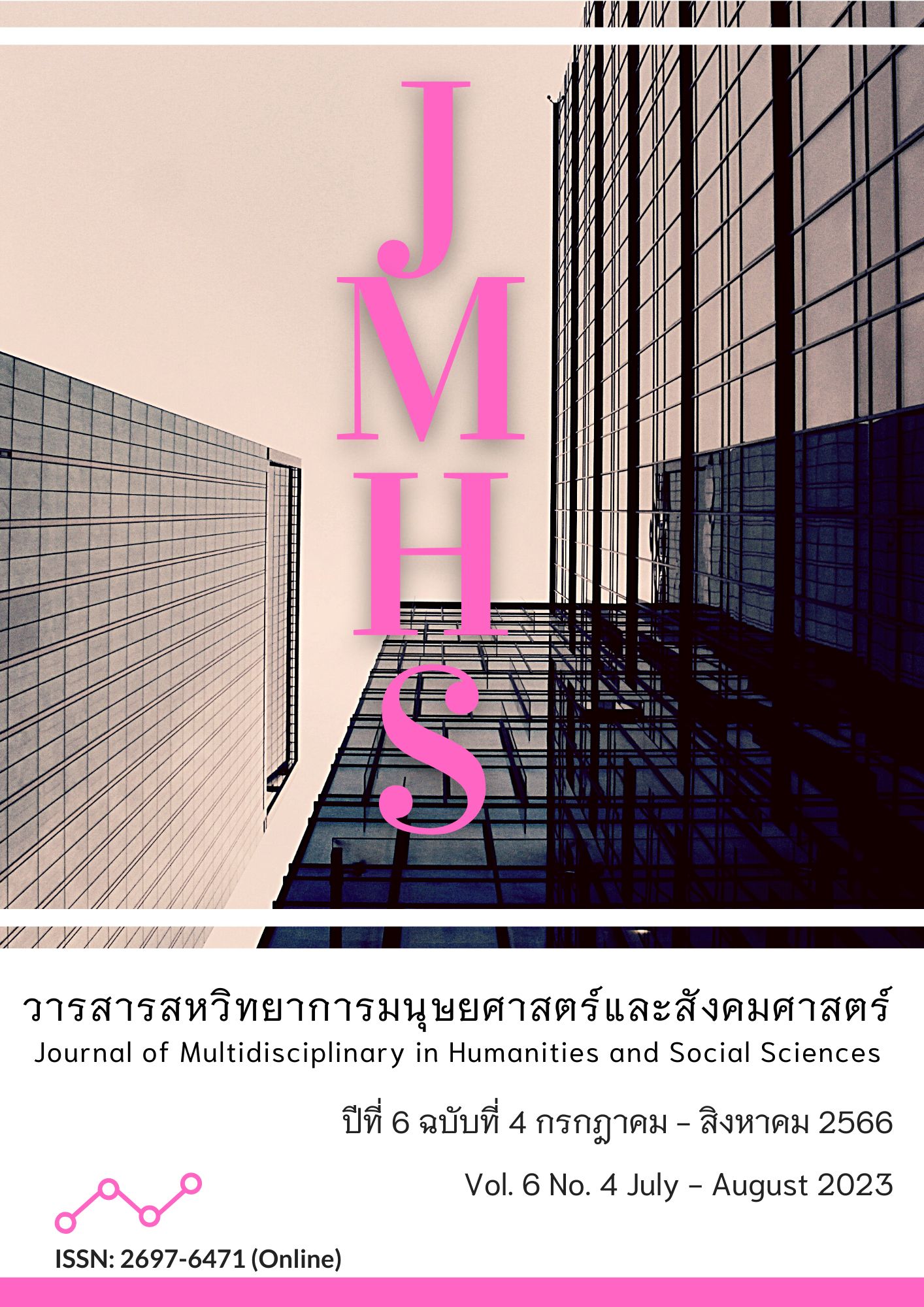Causal Factors Influencing Word of Mouth of Cosmetic to Buy on LAZADA Application in Bangkok and Its Vicinity
Main Article Content
Abstract
The article aimed to 1) develop and validate a causal relationship model of word of mouth of cosmetics to buy on Lazada application in Bangkok and its vicinity, and 2) find causal factors Influencing word of mouth of cosmetics to buy on Lazada application in Bangkok and its vicinity. This study was quantitative research. The sample consisted of 397 people who had bought cosmetics on the Lazada application and lived in Bangkok and its vicinity. The tools used in the research were online questionnaires and convenience sampling. The statistics used in data analysis were frequency, percentage, confirmatory factor analysis, and the structural equation model. The results of this research were the development of causal relationship models consisting of 6 components: 1) credibility; 2) trust; 3) congruence; 4) attitudes; 5) loyalty; and 6) word of mouth. The model was consistent with the empirical data to a great extent. The statistics showed CMIN/df = 1.34, GFI = 0.94, AGFI = 0.90, SRMR = 0.05, and RMSEA = 0.03. The final prediction coefficient was 0.84, indicating that the variables in the model can explain the variance of the word of mouth of cosmetics to buy on Lazada by 84 percent. It was found that loyalty and congruence directly influence word of mouth. Entrepreneurs who sell cosmetics on the Lazada application can be used as a guideline to generate word of mouth for consumers to buy cosmetics on the Lazada application.
Article Details

This work is licensed under a Creative Commons Attribution-NonCommercial-NoDerivatives 4.0 International License.
Views and opinions appearing in the Journal it is the responsibility of the author of the article, and does not constitute the view and responsibility of the editorial team.
References
กระทรวงดิจิทัล เพื่อเศรษฐกิจและสังคม. (2565). รายงานผลการสำรวจพฤติกรรมผู้ใช้งานอินเทอร์เน็ตในประเทศไทย ปี 2565. สืบค้นเมื่อ 10 มีนาคม 2566, จาก https://www.etda.or.th/getattachment/78750426-4a58-4c36-85d3-d1c11c3db1f3/IUB-65-Final.pdf.aspx
กัณฐิกา จิตติจรุงลาภ. (2562). การสื่อสารแบบปากต่อปากอิเล็กทรอนิกส์ต่อพฤติกรรมการซื้อสินค้าออนไลน์. วารสารระบบสารสนเทศด้านธุรกิจ, 5(2), 43–65. DOI: 10.14456/jisb.2019.8
ชัญญา นุตตะไลย์ และ สมชาย เล็กเจริญ. (2565). ปัจจัยเชิงสาเหตุที่มีอิทธิพลต่อความตั้งใจซื้อบัตรคอนเสิร์ตบนแอปพลิเคชันทิคเก็ตเมล่อนของผู้บริโภคในเขตกรุงเทพมหานครและปริมณฑล. วารสารบัณฑิตศาส์น มหาวิทยาลัยมหากุฏราชวิทยาลัย, 20(1), 15-24. สืบค้นจาก https://so04.tci-thaijo.org/index.php/mgsj/issue/view/17459
ณวรรษ ชัยศรี และ สมชาย เล็กเจริญ. (2563). ปัจจัยเชิงสาเหตุที่มีผลต่อความตั้งใจซื้อสินค้าแฟชั่นบนอินสตาแกรมของผู้บริโภคในประเทศไทย. วารสารศิลปการจัดการ, 5(2), 512-528. สืบค้นจาก https://so02.tci-thaijo.org/index.php/jam/issue/view/16675
ธัญ ธำรงนาวาสวัสดิ์. (2565). The Trust Equation. สืบค้นเมื่อ 10 มกราคม 2566, จาก https://www.slingshot.co.th/blog/thetrust
นัทธมน พลายบัว และ สุมามาลย์ ปานคำ. (2564). ปัจจัยเชิงสาเหตุที่มีผลต่อการบอกต่อแบบปากต่อปากเชิงบวก ทางอิเล็กทรอนิกส์บนเพจเฟซบุ๊กเกี่ยวกับสถานที่ท่องเที่ยวเชิงวัฒนธรรมของนักท่องเที่ยวชาวไทย. วารสารสหวิทยาการมนุษยศาสตร์และสังคมศาสตร์. 4(3), 842-856. สืบค้นจาก https://so04.tci-thaijo.org/index.php/jmhs1_s/issue/view/16737
ปรีดี นุกุลสมปรารถนา. (2565). 5 ปัจจัยหลักสู่ความน่าเชื่อถือของการทำธุรกิจ. สืบค้นเมื่อ 10 มกราคม 2566, จาก https://www.popticles.com/business/5-factors-to-win-business-credibility/
ผู้จัดการออนไลน์. (2565). “ลาซาด้า” เผยสถิติแคมเปญ10ปี ผู้หญิงนักช้อปล่าส่วนลดกลุ่มใหญ่สุด. สืบค้นเมื่อ 10 เมษายน 2566, จาก https://mgronline.com/business/detail/9650000035180
พันธ์กานต์ ทศแสนสิน และ สุมามาลย์ ปานคำ. (2562). รูปแบบความสัมพันธ์เชิงสาเหตุพฤติกรรมการบอกต่อแบบปากต่อปากในการเลือกซื้ออาหารสัตว์เลี้ยงผ่านเฟซบุ๊กของผู้บริโภค ในเขตกรุงเทพมหานครและปริมณฑล. วารสารบัณฑิตศาส์น มหาวิทยาลัยมหามกุฏราชวิทยาลัย, 17(1), 147-158. สืบค้นจาก https://so04.tci-thaijo.org/index.php/mgsj/issue/view/15252
วิทวัส รุ่งเรืองผล. (2562). เส้นทางสู่ความภักดี From Customer Journey to Brand Loyalty. สืบค้นเมื่อ 10 มกราคม 2566, จาก https://marketeeronline.co/archives/91075.
ศรุตา กาลวันตวานิช และ สุมามาลย์ ปานคำ. (2564). ปัจจัยเชิงสาเหตุที่มีอิทธิพลต่อความตั้งใจใช้บริการรับชมภาพยนตร์บนแอปพลิเคชันดิสนีย์พลัสฮอตสตาร์ของผู้บริโภคในประเทศไทย. วารสารสหวิทยาการมนุษย์ศาสตร์และสังคมศาสตร์, 5(3), 1040-1055. สืบค้นจาก https://so04.tci-thaijo.org/index.php/jmhs1_s/issue/view/17160
สุประวีณ์ ดาวแดน และ สมชาย เล็กเจริญ. (2563). ปัจจัยเชิงสาเหตุที่มีอิทธิพลต่อความภักดีในการซื้อสินค้าของบริษัท แซนนิต้า อินเตอร์เนชั่นแนล จำกัด ผ่านแอปพลิเคชันช็อปปี้ของผู้บริโภคในเขตกรุงเทพมหานครและปริมณฑล. วารสารรังสิตสารสนเทศ, 28(1), 38-57. สืบค้นจาก https://rilj.rsu.ac.th/journal/57
สุริยน การะเวก และ อัฏฐมา บุญปาลิต. (2564). คุณภาพการบริการ ความภักดีของผู้ใช้บริการที่ส่งผลต่อการสื่อสารแบบปากต่อปากในการทำธุรกิจโต๊ะจีน ในจังหวัดสุพรรณบุรี. วารสารวิชาการสถาบันวิทยาการจัดการแห่งแปซิฟิค สาขามนุษยศาสตร์และสังคมศาสตร์, 8(2), 525-533. สืบค้นจาก https://so05.tci-thaijo.org/index.php/pacific/issue/view/17269
สำนักงานนโยบายและยุทธศาสตร์การค้า. (2564). พาณิชย์เผยโควิดดันยอดซื้อสินค้าออนไลน์เพิ่มขึ้น 0.45 เท่า. สืบค้นเมื่อ 10 มีนาคม 2566, จาก https://www.price.moc.go.th/price/fileuploader/file_admin_sum/news_survey-042564.pdf
สำนักงานพัฒนาธุรกรรมทางอิเล็กทรอนิกส์. (2565). การสำรวจพฤติกรรมผู้ใช้อินเทอร์เน็ตในประเทศไทย Thailand Internet User Behavior ปี 2565. สืบค้นเมื่อ 28 ตุลาคม 2565, จาก https://www.etda.or.th/th/Our-Service/statistics-and-information/IUB2022.aspx
อังค์วรา เพียรธรรม และ พรพรหม ชมงาม. (2559). ความสัมพันธ์ระหว่างการยอมรับความน่าเชื่อถือและความเชื่อมั่นต่อทูตตราสินค้าของผู้ใช้บริการสถาบันการเงินในเขตกรุงเทพมหานคร. วารสารสุทธิปริทัศน์, 30(95), 116-129. สืบค้นจาก https://so05.tci-thaijo.org/index.php/PUSuthiparithatJournal/issue/view/16602
อิสริยาภรณ์ อัศเวศน์ และ ระบิล พ้นภัย. (2565). ทัศนคติและคุณภาพการบริการที่ส่งผลต่อความภักดีในตราสินค้าวิดีโอสตรีมมิ่งของผู้บริโภคในเขตกรุงเทพมหานคร. วารสารวิทยาการจัดการปริทัศน์, 24(1), 1-10. สืบค้นจาก https://so03.tci-thaijo.org/index.php/msaru/article/View/257593
Alguacil, M., Núnez, J., Calabuig, F., Escamilla, P., & Staskeviciute, I. (2021). Creation of A Brand Model Through SEM to Predict Users’ Loyalty and Recommendations Regarding a Public Sports Service. Heliyon, 7(1), 1-8. https://doi.org/10.1016/j.heliyon.2021.e07163
Alguacil, M., Sanchez, J., & Valantine, I. (2019). Be Congruent and I Will Be Loyal: The Case of Sport Services. Sport in Society, 23(2), 234–248. https://doi.org/10.1080/17430437.2019.1607305
Hair, J. F., Black, W. C., Babin, B. J., & Anderson, R. E. (2010). Multivariate Data Analysis. (7th ed.). New Jersey: Prentice Hall.
Hair, J. F., Hult, G. T. M., Ringle, C. M., & Sarstedt, M. (2014). A Primer on Partial Least Squares Structural Equation Modeling (PLS-SEM). California: Sage Publications.
Hoelter, J.W. (1983). The Effects of Role Evaluation and Commitment on Identity Salience. Social Psychology Quarterly, 46(2), 140–147. https://doi.org/10.2307/3033850
Hu, L.T., & Bentler, P. M. (1999). Cutoff Criteria for Fit Indexes in Covariance Structure Analysis: Conventional Criteria Versus New Alternatives. Structural Equation Modeling, 6(1), 1–55. https://doi.org/10.1080/10705519909540118
Huber, F., Eisele, A., & Meyer, F. (2018) The Role of Actual, Ideal, and Ought Self-Congruence in The Consumption of Hedonic Versus Utilitarian Brands. Psychol Mark, 35(1), 47–63. https://doi.org/10.1002/mar.21070
Joreskog, K. G., & Sorbom, D. (1984). Advances in Factor Analysis and Structural Equation Models. Lanham: Rowman & Littlefield.
Kim, Y., & Yang, B. (2018). Self-Congruence and Word of Mouth (WOM): Serial Multiple Mediation of Brand Tribalism and Brand Relationship. International Journal of Pure and Applied Mathematics, 120(6), 5409–5426.
Kline, R. B. (2011). Principles and Practices of Structural Equation Modeling. (3rd ed.). New York: The Guilford.
Schreiber, J. B., Stage, F. K., King, J., Nora, A., & Barlow, E. A. (2006). Reporting Structural Equation Modeling and Confirmatory Factor Analysis Results: A Review. The Journal of Educational Research, 99(6), 323–337. https://doi.org/10.3200/JOER.99.6.323-338
Schumacker, R. E., & Lomax, R. G. (2004). A Beginner's Guide to Structural Equation Modeling. (2nd ed.). Lawrence Erlbaum Associates Publishers.
Suhaily, L., & Soelasih, Y. (2017). What Effect Repurchase Intention of Online Shopping. International Business Research, 10(12), 113-122. https://doi.org/10.5539/ibr.v10n12p113
Thompson, B. (2004). Exploratory and Confirmatory Factor Analysis: Understanding Concepts and Applications. American Psychological Association.
Ullman, M. T. (2001). The Declarative/Procedural Model of Lexicon and Grammar. Journal of Psycholinguistic Research, 30(1), 37–69. https://doi.org/10.1023/A:1005204207369


